3-Month 20x Surge: Does ZEC's 'Bitcoin Silver' Narrative Hold Up?
You bought ZEC, I bought ETH, we both have a bright future
The cypherpunk's pursuit of privacy can be traced back to the birth of Bitcoin 16 years ago, embedding a privacy mechanism in a fully transparent ledger, thus opening up the entire cryptocurrency world. And to this day, privacy in the crypto field remains a significant topic.
If you bought ZEC at the first shout-out by this round's coin circle "version child" Mert and held it until now, in less than 3 months, you would achieve a rare 20x gain among altcoins this year.

When ZEC surged from $238 to $580 within 40 days, achieving a 20x increase in three months and hitting a seven-year high, the crypto market realized that a long-forgotten sector was making a strong comeback. The entire privacy coin sector surged by about 80% in the past 7 days, with established projects like DASH, DCR, ZEN seeing gains of over 100%.
What is even more surprising is the shift in market sentiment. Just a few months ago, privacy coins were still labeled as "regulatory orphans," with Kraken delisting XMR and the EU proposing a 2027 ban, making investors stay away. But now, "privacy is a necessity, not a feature" has become a high-frequency topic on Twitter, Arthur Hayes publicly setting a "ZEC target of $10,000," and Vitalik endorsing ZKSync multiple times.
What is the real driving force behind this rally? Is it the demand for hedging under regulatory pressure, or pure financial speculation? More importantly, how long can this wave of enthusiasm last?
Who is Leading the Surge?
ZEC is undoubtedly the absolute leader of this round's rally. Starting from $237.84 on October 23 to reaching $532.06 on November 7, a 120% increase in 40 days, with a staggering 700% YTD gain. This price not only set a new high since 2018 but also brought ZEC back into the mainstream investors' view.
Looking back at several key points in time, you can clearly see ZEC's upward trajectory:
October 1: Grayscale announced the reopening of the ZEC Trust (ZCSH) and provided fee reductions and staking functionality, causing a 22% surge in ZEC on that day;
October 24: A technical formation of a "flag pattern breakout" occurred, with on-chain indicators OBV and CMF rising simultaneously, leading to a 40% increase within 4 days;
November 1: The Futures Open Interest (OI) first broke through $770 million, with Arthur Hayes once again calling for a "target of $10,000," triggering a short squeeze and a 15% intraday gain;
November 7: The price broke through $532, with a 24-hour spot trading volume of $17.5 billion, 1.4 times the monthly average level;
Of more interest is the improvement in fundamentals: ZEC's shielded pool balance first broke through 5 million coins, accounting for approximately 30% of the circulation, equivalent to $25 billion in funds opting for completely anonymous storage. Daily transaction volume has increased from 10,000 to 12,600 transactions, with shielded transactions accounting for less than 10% jumping to 25-30%. These data indicate that ZEC's rise is not purely speculative but is supported by real privacy needs.
ZEC's strong performance ignited the entire privacy sector, with a group of long-forgotten old projects also experiencing a breakout:

Behind this collective uptrend are two key drivers:
First is the centralized listing on exchanges. From November 2-6, Binance, OKX, and Bitget successively launched perpetual contracts or new spot trading pairs for DASH, ZEN, SCRT, bringing not only improved liquidity but also the magnifying effect of high-leverage derivatives. Taking DASH as an example, the 24-hour spot plus contract trading volume broke through $1.2 billion, a 2.8-fold increase compared to the previous period.
The second is substantive progress in technology or protocols. DASH became the native asset of the Maya Protocol on November 2, achieving cross-chain anonymous exchange functionality; ZEN completed its migration to Base L2, doubling the efficiency of zk-SNARK; SCRT and ROSE benefited from the new narrative of privacy computation combined with AI.
In addition, the privacy sector has a special player, ZKsync (ZK).
Technologically, ZK is Ethereum's Layer-2 scaling solution, with transactions on the main chain still transparent; but because of its optional ZK privacy feature and Prividium Enterprise Private Chain, mainstream platforms such as CoinGecko and Santiment categorize it under the privacy sector.
Over the past 7 days, ZK has surged over 130%, becoming one of the projects with the largest gains in the privacy sector. This performance is backed by a triple catalyst:
Performance leap of the Atlas upgrade: The Atlas upgrade, fully activated on November 1, increased the theoretical TPS from 2,000 to 15,000-30,000. ZK's finality was reduced from 3 hours to 1 second, and the transaction fee per transaction dropped from over $0.0013 to below $0.0001. Previously, ZK's major limitation was its high fee cost compared to OP, but after the Atlas upgrade, this issue has been significantly improved.
Tokenomics model reconfiguration: The "ZKnomics Part I" proposal, announced on November 4, for the first time will flow network transaction fees and enterprise authorization fees back to the Treasury for "buyback-burn+staking rewards," transforming ZK from a pure governance token to a cash flow asset. The estimated staking APY can reach 8-12%.
Vitalik's public endorsement: On November 1, Vitalik tweeted twice stating that ZKsync is "underrated," resulting in a 30x increase in ZK's trading volume that day. The endorsement of a key figure played a crucial catalyst role in market sentiment.
What are the reasons behind the rise of the privacy narrative?
Regulatory "Safe Haven Premium"
At first glance, regulatory tightening should suppress privacy coins, but in reality, it is the opposite. It is precisely because of high regulatory pressure that the demand for privacy is being ignited.
Regulatory tightening at the policy level is accelerating. The draft of the EU's Anti-Money Laundering Regulation clearly proposes to completely restrict privacy coins' transactions within the EU by 2027; the U.S. Financial Crimes Enforcement Network (FinCEN) is also planning to intensify scrutiny of "high-risk self-hosted wallets." With Bitcoin and Ethereum spot ETFs coming into regulatory view, all on-chain transactions face stricter tracking.
As compliant assets become more transparent, privacy assets become scarcer.
Therefore, Western media has even named this round of the rally — the "Crypto Anti-Surveillance Wave." ZEC and XMR are redefined as the "last line of on-chain anonymity." The consensus on social media is more direct: "Privacy is not a feature but a fundamental right."
On-chain data confirms the growth in real demand.
ZEC shielded pool balance increased from 4 million coins to 4.9 million coins in 40 days, a 25% increase; the proportion of shielded transactions surged from less than 10% to 25-30%, indicating that more and more users are opting for fully anonymous transaction methods. The more users, the stronger the privacy guarantee, and the more evident the network effect.
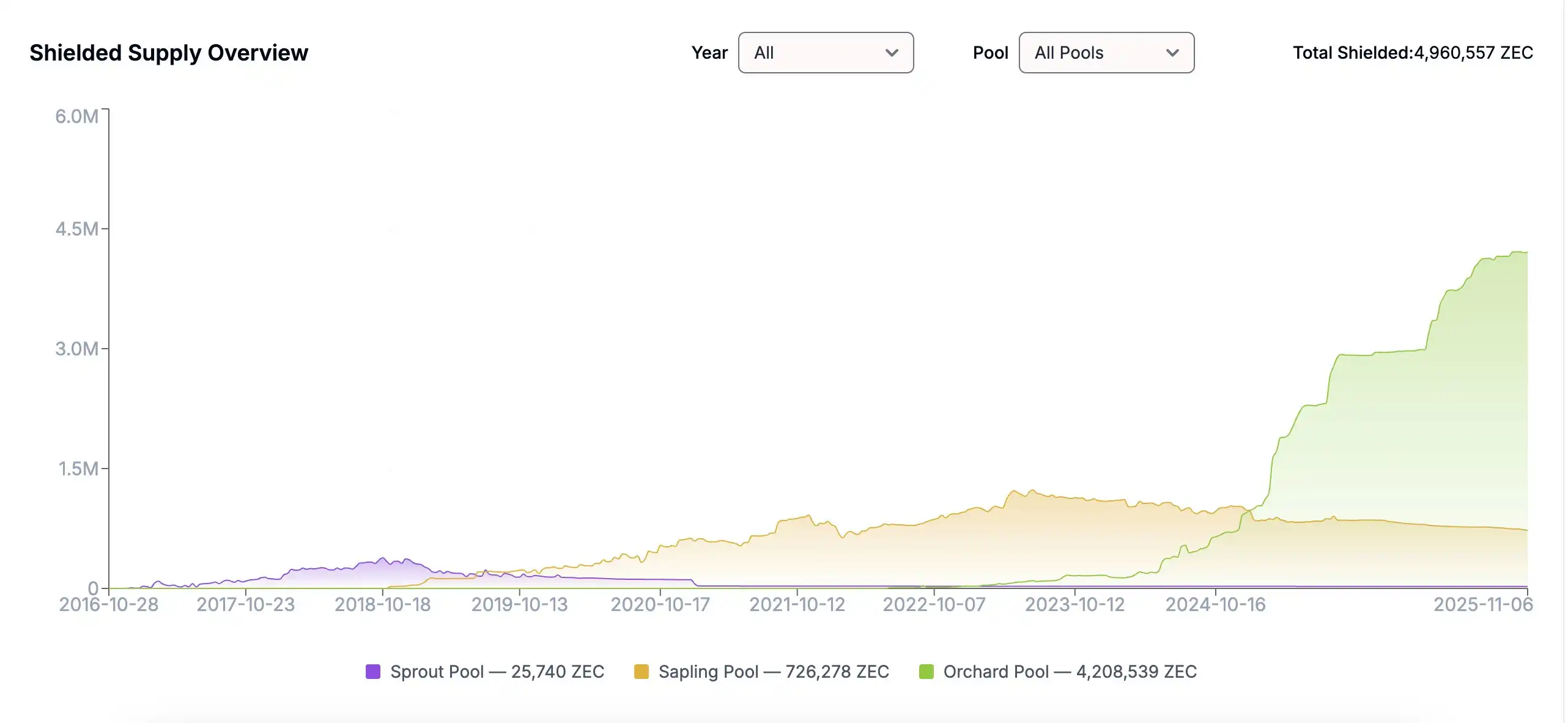
The increase in on-chain activity of ZEC, DASH, and ROSE is also significant evidence. ZEC's daily transaction volume has grown from around 10,000 transactions on October 1 to 12,600 transactions on November 7, a 26% increase. DASH's 30-day average on-chain transactions have increased by 15%, rising from around 1,300 transactions to 1,500 transactions; ROSE has seen a staggering 200% surge, climbing from around 3,300 transactions to 10,000 transactions.
The TVL inflow of ZK is also worth noting. Following the Atlas upgrade activation, the TVL of the ZKsync Era has rebounded from $5 billion to $6 billion, a 20% increase. This growth occurred against the backdrop of an overall decline in TVL across the Layer-2 ecosystem.
Transaction platform inflow data also reflects the trend of chip locking. ZEC's transaction platform net inflow in a 48-hour period plummeted from $41.8 million to $3.66 million, a 91% decrease. This indicates that holders are not engaging in short-term speculation but are optimistic about the long-term growth of privacy needs.
ZEC's Grayscale Effect
The return of institutional funds is one of the most important catalysts for this round of the market.
Grayscale's relaunch of the Grayscale ZEC Trust was the most significant event in October. On October 1, Grayscale announced the reopening of new subscriptions for the ZCSH Trust, offering two major upgrades: waiving the management fee and introducing staking capabilities, providing a 4-5% annualized return. This one-two punch significantly improved the risk-return ratio.
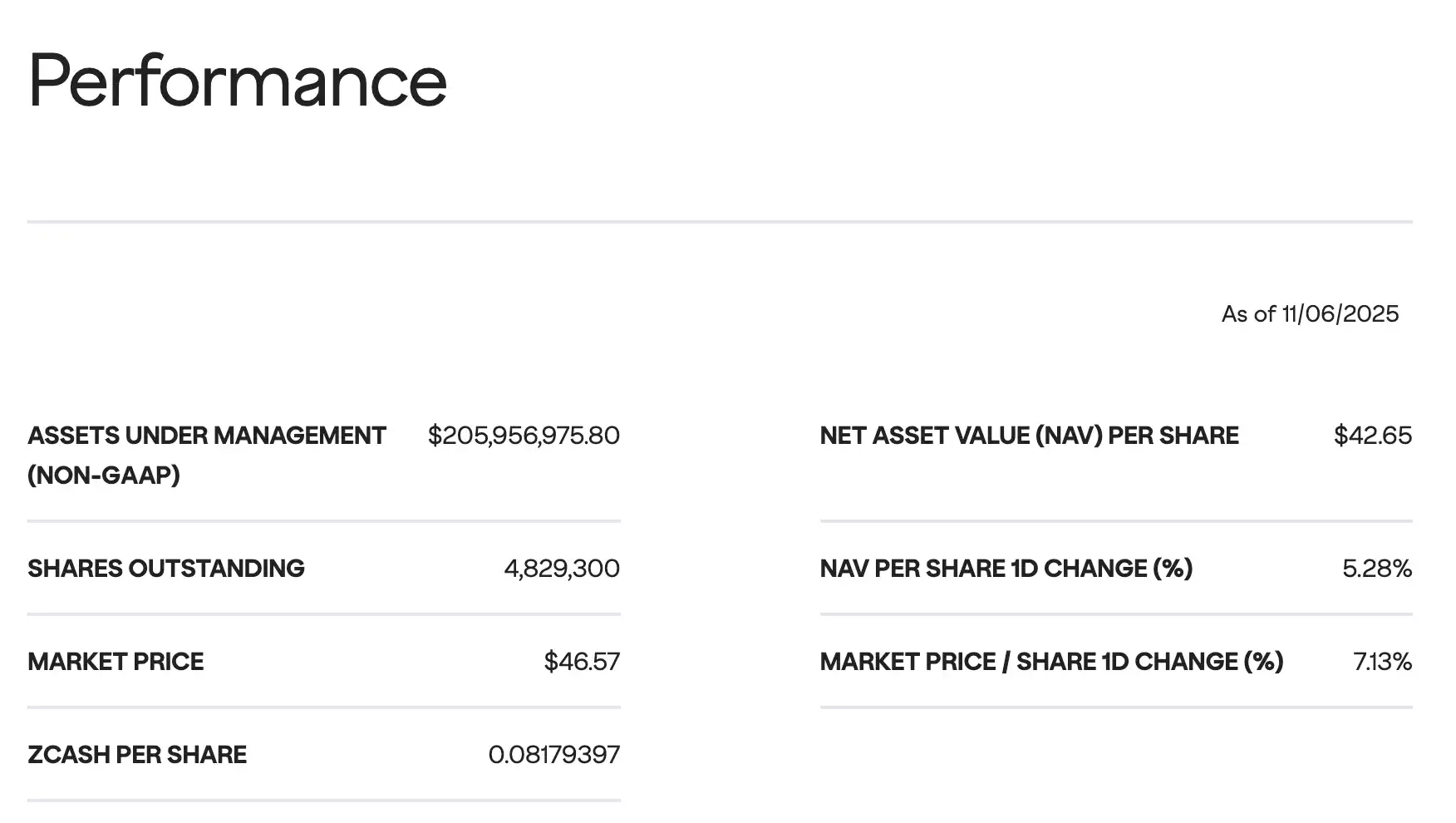
Why does the term "Grayscale" carry such weight? Because over the past decade, Grayscale has been almost the sole compliant bridge and price oracle for traditional institutional crypto asset allocation. Its trust products issued in the U.S. have long provided exposure to crypto assets for pension funds, family offices, and hedge funds, making it a leading indicator of institutional entry scale and preference changes.
Since launching its first Bitcoin Trust in 2013, Grayscale has successively expanded into over a dozen single-asset trusts such as ETH, SOL, LTC, BCH, ETC, FIL, XLM, among others. Many of these assets have experienced the typical "Grayscale Effect"—where capital inflows drive price increases, premiums widen, and a consensus narrative is formed. The ZEC Trust (ZCSH) was established as early as 2017 and experienced a phase of skyrocketing premiums during the 2020-2021 bull market, becoming a primary target for institutional allocation in the privacy sector.
However, following increased self-regulation and privacy coins facing compliance pressure, ZCSH paused subscriptions in 2022 and entered a quiet period in 2023. This reboot signifies Grayscale re-endorsing privacy assets, with its signaling significance even greater than the funds themselves.
Data shows that ZCSH's AUM (Assets Under Management) surged by 228% in one month, rising from around $42 million to $136 million, representing approximately 1.9% of ZEC's circulating supply. For an asset with daily trading volumes in the billions of dollars, the fact that nearly 2% of the chips are locked up long-term in the trust has a significant effect on the supply side.
A deeper logic lies in the ETF's circuitous effect. The approval of Bitcoin and Ethereum physically settled ETFs brought these assets into a strict regulatory framework, where every transaction is traceable. Some institutions and high-net-worth individuals, to avoid this transparency, began redirecting funds to anonymous assets. Grayscale's ZEC Trust conveniently offers a compliant channel — providing exposure to privacy coins while enabling operations through traditional financial channels.
The Coordinated Position of CoinCircle's Version Sons
Social media has played an amplifier role in this round of the market.
During ZEC's uptrend, Mert, widely regarded as the version son of the Solana ecosystem in this round, undoubtedly played one of the most crucial voices behind the price. As the CEO of Helius, a core infrastructure of Solana, and one of the most recognized voices in the Solana ecosystem, Mert began heavily recommending ZEC when it was at $30, and almost daily continued to make calls on Twitter, live, and podcasts. This led to a significant overlap between the ZEC and Solana communities.
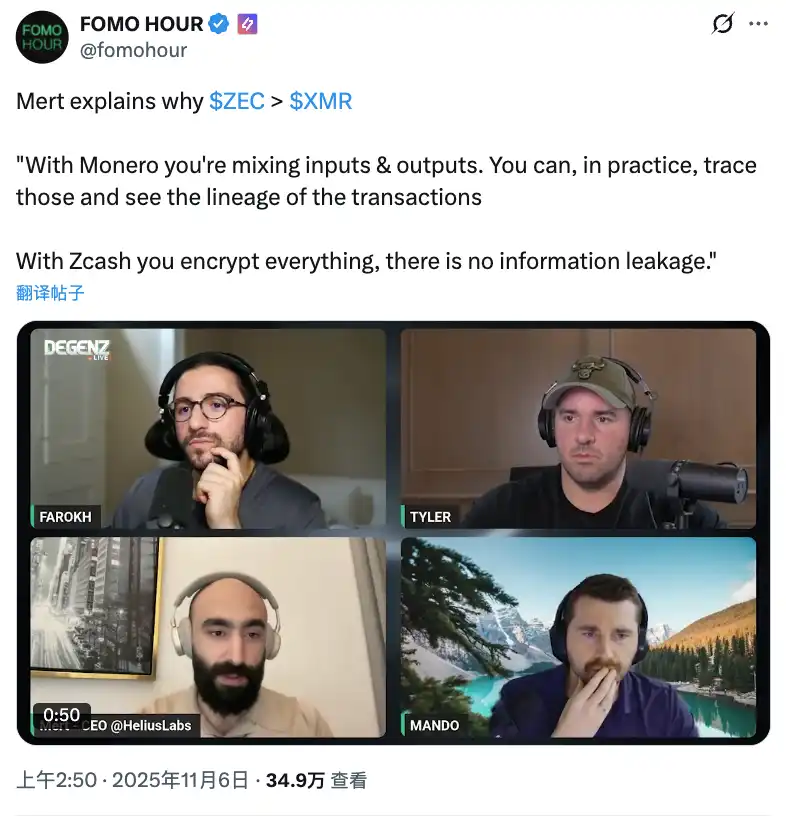
Even more catalytic was Arthur Hayes' consecutive entry calls. The co-founder of BitMEX was one of the "most adept at forecasting cycle inflection points" in the last bull market. He first threw out the "ZEC target $1,000" on October 31, which was already astonishing; then on November 1, he directly doubled down to "target $10,000" and dubbed ZEC the "safe-haven asset of the crypto market." This tweet's interactions exceeded 200,000 in a single day, causing ZEC's trading volume to soar and its price to spike 15% intraday.

Subsequently, Naval Ravikant's statement elevated ZEC's narrative from being a "speculative asset" to a "battle of values and technological direction." Naval redefined the foundational value of privacy assets with the statement "Privacy is a basic right, not a tool for crime."
As the self-proclaimed "ZK enthusiast," Vitalik's consecutive tweets on November 1st referred to ZKsync as "underrated," directly causing a 30x surge in ZK-related asset trading volume, igniting the ZK track, and making "ZK Season is here" a hot topic.
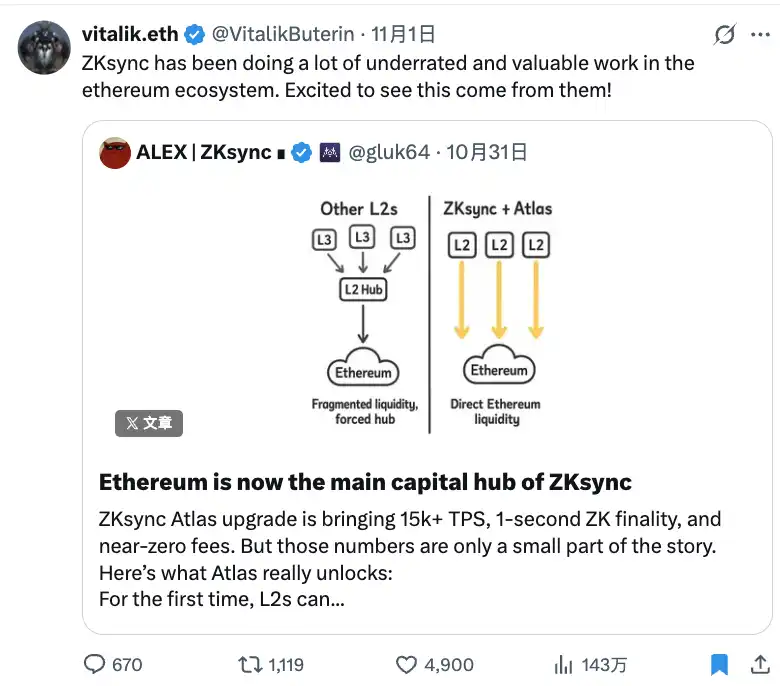
Is ZEC Really the "Silver to Bitcoin"?
During ZEC's price surge, the community also proposed a narrative of "Bitcoin's Silver." Does this positioning really hold water?
Optimists believe that ZEC's rise is not solely due to the privacy narrative. One key piece of evidence is the market performance divergence: if ZEC's surge was solely due to privacy demand, then RAIL, as a core privacy project in the EVM ecosystem, should have seen simultaneous benefits.
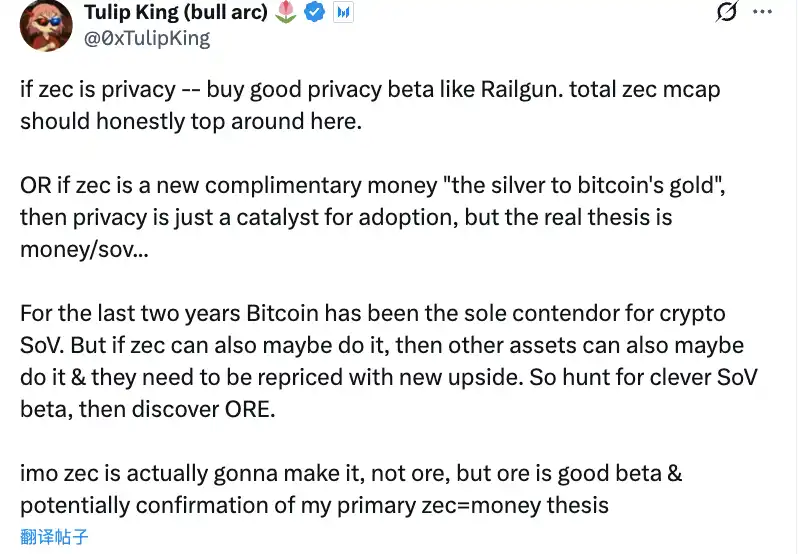
RAIL is a privacy protocol in the Ethereum ecosystem that can anonymize ETH, ERC-20 tokens, and NFTs. More importantly, Vitalik himself not only used RAIL to anonymize millions of dollars' worth of ETH but also natively integrated RAIL into his new project Kohaku (a wallet SDK), with MetaMask and OKX Wallet as partners. From a fundamental perspective, RAIL charges a 0.25% fee on funds entering and exiting privacy pools, and 77% of the token supply is staked, locked for 30 days, resulting in a much lower actual circulation supply than surface data shows. This is a project with a clear business model and tokenomics, rather than just a speculative asset.
However, in the latter half of October, the market witnessed a crucial signal: ZEC continued its meteoric rise, while RAIL began to stagnate. This might indicate that ZEC's surge may be not only about privacy but about the market re-evaluating its monetary properties and value storage function. In other words, privacy may be just a catalyst, and the real narrative is whether "ZEC can become the silver to Bitcoin" — a narrative with a higher ceiling.
The optimists believe that ZEC has all the elements to become the "silver to Bitcoin's gold." From a technical perspective, ZEC uses a Proof of Work (POW) mechanism, similar to Bitcoin, to secure the network through hashrate competition, which aligns more with the principle of "monetary neutrality" than Proof of Stake (POS)—no one can control the network through coin holdings. ZEC has a fixed total supply of 21 million coins, and this hard cap supply mechanism is a core feature of a store of value asset, mitigating the risk of inflation dilution. More importantly, ZEC's privacy feature is not a burden but an advantage: in a world of increasing regulation and fully transparent on-chain transactions, privacy is shifting from an "optional feature" to a "monetary necessity." When every Bitcoin transaction can be traced, and every address can be identified, ZEC's shielded transactions offer true fungibility—a fundamental property of money.
Looking at the valuation space, optimists also point out that ZEC's market cap is still extremely low compared to Bitcoin, indicating a significant revaluation potential. If ZEC is indeed accepted by the market as a store of value asset, even capturing just 5-10% of Bitcoin's market share would imply a multiple-fold increase. Historically, the value ratio of silver to gold has fluctuated between 1:50 and 1:80 for a long time, and if measured by the same logic, ZEC has a significant valuation gap to bridge relative to Bitcoin.
However, the pessimists offer a completely different perspective.
They argue that if ZEC's value truly lies in "currency/store of value," then the true challenger to Bitcoin would be Ethereum, not ZEC.
Ethereum not only has smart contracts, a massive DeFi ecosystem, and institutional recognition, but more importantly, it has effectively taken on the role of "programmable money"—with billions of dollars in stablecoins circulating on Ethereum and hundreds of billions of dollars in value locked in Ethereum's DeFi protocols. In comparison, while ZEC has privacy and a fixed supply, it lacks ecosystem depth and use cases, making it more like a "single-function tool" rather than an "all-encompassing currency."
Within this framework, the pessimists are more bullish on projects like Railgun. RAIL enhances Ethereum's privacy, effectively improving ETH's monetary properties. This means that RAIL is not only a benefactor of the privacy narrative but also of Ethereum's monetary narrative—it stands on top of a larger, more mature ecosystem, rather than attempting to build a new monetary system from scratch.
From a valuation perspective, there is a significant difference in the upside potential of the two. If RAIL were to rise 20x, its fully diluted valuation (FDV) would reach $4 billion, which is in line with the valuations of other top projects in the Ethereum ecosystem and easily comprehensible and acceptable to the market. However, if ZEC were to increase by 20x, its FDV would reach $160 billion, becoming the third-largest cryptocurrency by market cap, only behind Bitcoin and Ethereum. This would require the market to truly believe that ZEC can stand shoulder to shoulder with Bitcoin and Ethereum—a very high threshold.
This is not an issue that can be resolved through theoretical debate; rather, it requires the market to answer through actual action: Will the shielded pool balance of ZEC continue to grow in the next 12-24 months? Will institutions allocate ZEC through compliant channels such as Grayscale? Will regulatory pressure crush ZEC or instead strengthen its scarcity?
The answers to these questions will determine whether ZEC's "Bitcoin Silver" narrative can be established and will also determine the sustainability and depth of this round of privacy coin market.
Disclaimer: The content of this article solely reflects the author's opinion and does not represent the platform in any capacity. This article is not intended to serve as a reference for making investment decisions.
You may also like
Universal Exchange
This article will explore how Coinbase's diversified businesses work together to achieve its vision.

DeFi faces a potential $8 billion risk, but only $100 million has exploded so far
Interview with RaveDAO Head of Operations: Breaking Barriers with Music, Enabling Real Users to Onboard to Blockchain Seamlessly
RaveDAO is not just about organizing events; it is creating a Web3-native cultural ecosystem by integrating entertainment, technology, and community.

Behind the x402 Craze: How ERC-8004 Builds the Trust Foundation for AI Agents
If x402 is the “currency” of the machine economy, then what ERC-8004 provides is the “passport” and “credit report.”

